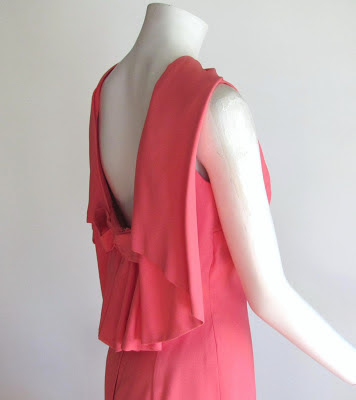Here's how to sew five classic prom or party dresses from the very early 1950's (and late 1940's). By using one of the current sewing patterns here, these styles can be made for today's parties, weddings and proms. I also included the cute swing coat jacket shown here as a party cover-up.
It's great how many magazine archives are now online. The Australian Home Journal collection from the late 1940's through early 1950's has monthly fashion features such as the two pages shown here showing spring gowns that could be sewn by most women at home. These are easy to sew styles that feature simple but effective details.
Illustration above, Spring 1951:
A-ballet length gown with bertha style collar, B-swing coat,
C-gown with sweetheart neckline, D-Gown with long sleeves
Illustration above, Spring 1949:
E-short sleeves with puffed trim, F-sweetheart neckline with lace trim
G-draped shelf bra bodice with short puffed sleeves
To create your own version of a late 1940's or early 1950's party dress or prom gown, I have found some current patterns that will help you to sew up a vintage party dress of your own. Select the view above that you like, and you'll find the modern pattern to make it up listed below.
 |
View A- Butterick 6022 has a similar bertha collar that can be sewn in contrast print or lace and made with or without sleeves.
View B- Vogue 8146 includes a short swing coat that could be worn with the collar turned up.
Views C and F- Curved sweetheart necklines are seen in both illustrations. A good pattern for the sweetheart necklines is McCall's 7281, which features a princess seamed bodice for a great fit. McCalls 7049 has two sweetheart strapless bodices, one that is simple darts, the other with princess seamlines. To get the curved bodice line in B, add a fold of ribbon around the sweetheart neckline. For F add ruffled lace edging and "pinch" a few gathers into center front bustline.
View E- Butterick 6022 has a good bodice, low waist and short sleeves for this look. Also, McCall's 7083 is a basic dress pattern with sleeves and princess seamed bodice that can be used. If the neckline were lowered and a puffed edge of chiffon trim were added, this same look could be achieved.
View G-The last dress with draped neckline looks almost like a shelf bra and is similar to Butterick 5882, although this pattern does not have sleeves.
I had to include this cute tip for a little puffed sleeve to wear with a strapless bodice. It's as simple as a tube of fabric with elastic at the top edge. The dress is similar to View F above, and the illustration here shows how the front has a line of gathers up the center that emphasizes the sweetheart neckline shape.
Fabric suggestions are for soft, not stiff, fabrics that have some weight like satin, taffeta, faille or crepe. It should also be noted that bodices had few bones to support the styles. These were often in the side seams only. Zippers were popular in the left side seam, instead of the back seam. This was to keep the back view pretty and smooth, without the look of a zipper showing down the back.













































